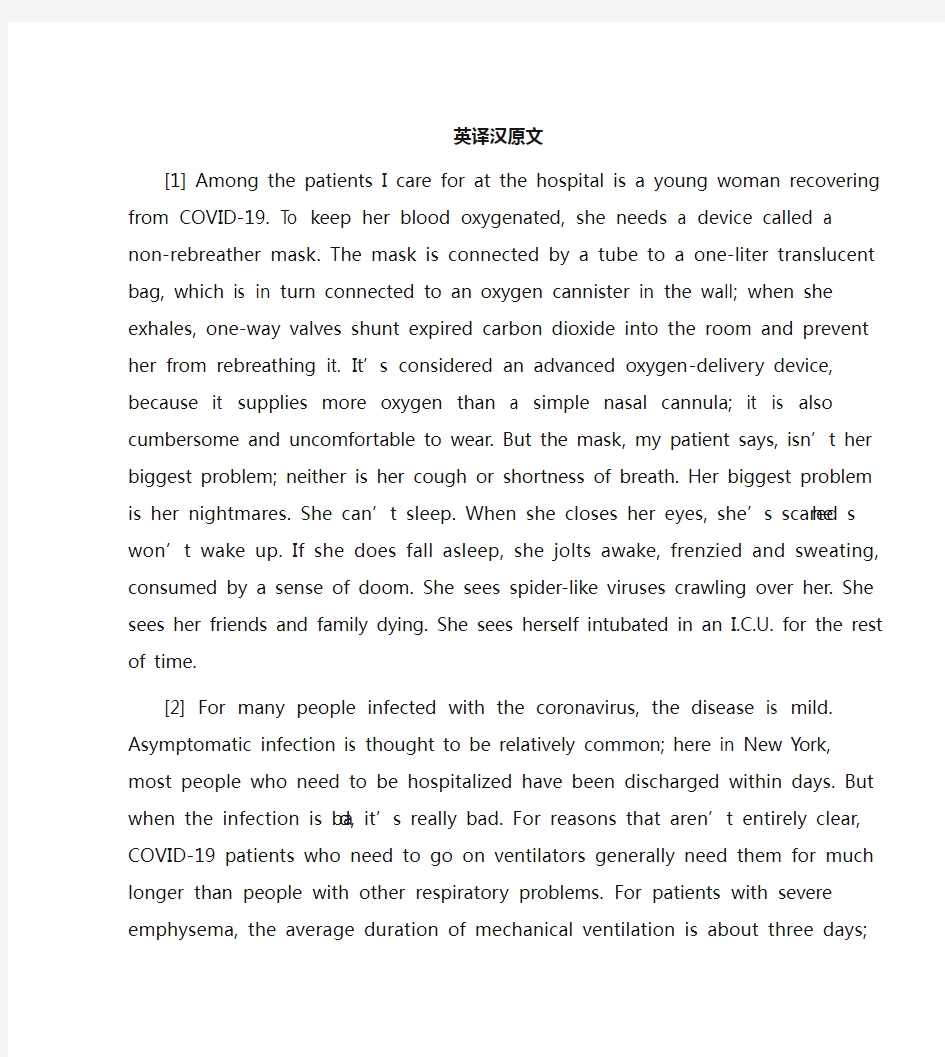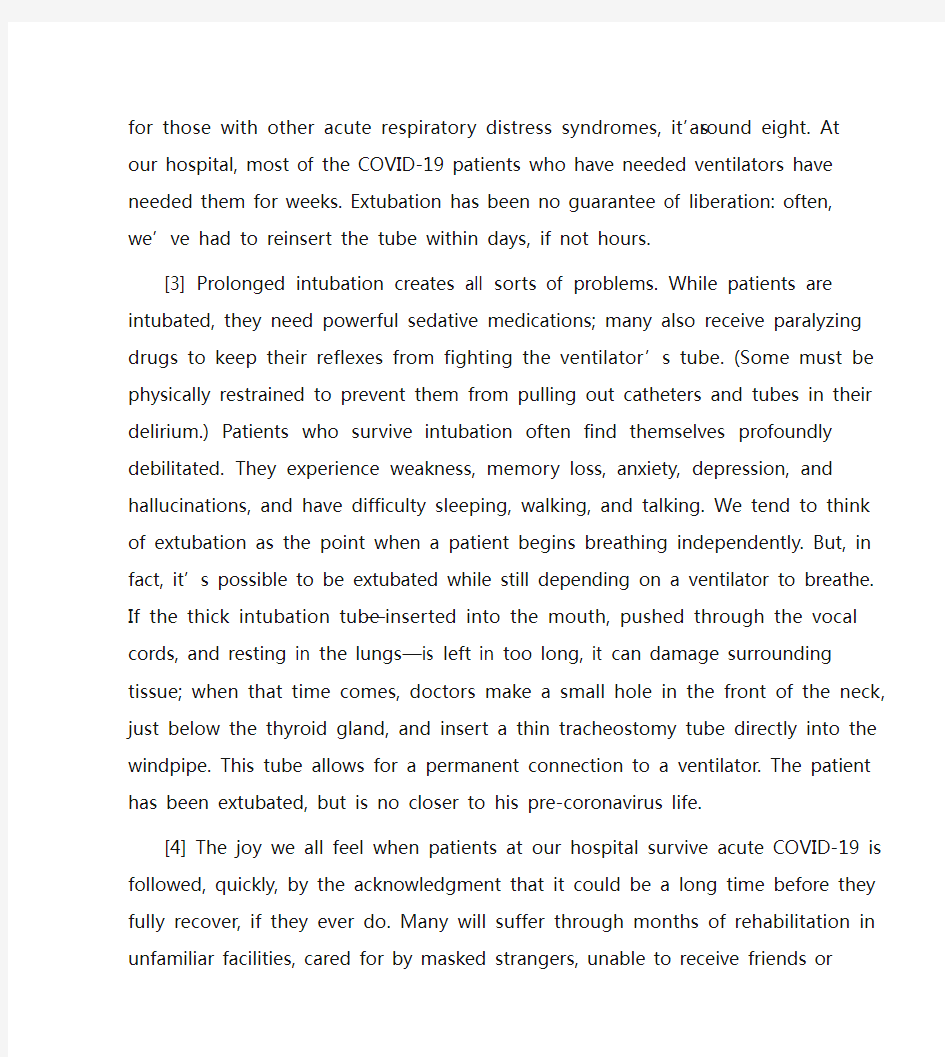整理新视野大学英语第三版读写教程课文翻译


英译汉原文
[1] Among the patients I care for at the hospital is a young woman recovering from COVID-19. To keep her blood oxygenated, she needs a device called a non-rebreather mask. The mask is connected by a tube to a one-liter translucent bag, which is in turn connected to an oxygen cannister in the wall; when she exhales, one-way valves shunt expired carbon dioxide into the room and prevent her from rebreathing it. It’s considered an advanced oxygen-delivery device, because it supplies more oxygen than a simple nasal cannula; it is also cumbersome and uncomfortable to wear. But the mask, my patient says, isn’t her biggest problem; neither is her cough or shortness of breath. Her biggest problem is her nightmares. She can’t sleep. When she closes her eyes, she’s scared she won’t wake up. If she does fall asleep, she jolts awake, frenzied and sweating, consumed by a sense of doom. She sees spider-like viruses crawling over her. She sees her friends and family dying. She sees herself intubated in an I.C.U. for the rest of time.
[2] For many people infected with the coronavirus, the disease is mild. Asymptomatic infection is thought to be relatively common; here in New York, most people who need to be hospitalized have been discharged within days. But when the infection is bad, it’s really bad. For reasons that aren’t
entirely clear, COVID-19 patients who need to go on ventilators generally need them for much longer than people with other respiratory problems. For patients with severe emphysema, the average duration of mechanical ventilation is about three days; for those with other acute respiratory distress syndromes, it’s around eight. At our hospital, most of the COVID-19 patients who have needed ventilators have needed them for weeks. Extubation has been no guarantee of liberation: often, we’ve had to reinsert the tube within days, if not hours.
[3] Prolonged intubation creates all sorts of problems. While patients are intubated, they need powerful sedative medications; many also receive paralyzing drugs to keep their reflexes from fighting the ventilator’s tube. (Some must be physically restrained to prevent them from pulling out catheters and tubes in their delirium.) Patients who survive intubation often find themselves profoundly debilitated. They experience weakness, memory loss, anxiety, depression, and hallucinations, and have difficulty sleeping, walking, and talking. We tend to think of extubation as the point when a patient begins breathing independ ently. But, in fact, it’s possible to be extubated while still depending on a ventilator to breathe. If the thick intubation tube—inserted into the mouth, pushed through the vocal cords, and resting in the lungs—is left in too long, it can damage surrounding tissue; when that time comes, doctors make a small hole in the front of the neck, just below the thyroid gland, and insert a thin tracheostomy tube directly into the windpipe. This tube allows for a permanent connection to a ventilator. The patient has been extubated, but is no closer to his pre-coronavirus life.
[4] The joy we all feel when patients at our hospital survive acute COVID-19 is followed, quickly, by the acknowledgment that it could be a long time before they fully recover, if they ever do. Many will suffer through months of rehabilitation in unfamiliar facilities, cared for by masked strangers, unable
to receive friends or loved ones. Families who just weeks ago had been happy, healthy, and intact now face the prospect of prolonged separation. Many spouses and children will become caregivers, which comes with its own emotional and physical challenges. Roughly two-thirds of family caregivers show depressive symptoms after a loved one’s stay in the I.C.U. Many continue to struggle years later.
[5] To contend with the flood of patients who will be extubated in the coming weeks, we’re planning to create a COVID-19 survivors unit. The unit will bring together clinicians from various backgrounds: hospitalists, pulmonologists, rehab specialists, psychiatrists, dieticians, therapists. It will develop COVID-19-specific protocols, which we hope will help patients progress to a fuller recovery. Patients will receive daily “pulmonary rehab”—a stepwise approach to reducing oxygen support and slowly building strength and endurance. They’ll learn breathing techniques and get help with gadgets they can use to clear mucus from the lungs. Some will be shown how to cough better. Physical and occupational therapists will help them recover motor skills that may have diminished during their hospitalizations; psychiatrists and nutritionists will help with mood and food. Many patients, because they are too sick, or need oxygen, or because no rehab facility will accept them, will need to spend days or weeks recovering in the hospital. The best thing we can do is create a home-like environment. The whole point is to help them stop being patients and start feeling human again.
汉译英原文
[1] 任何病毒感染性疾病,早期都会有病毒血症的表现。新型冠状病毒感染肺炎常见早期表现为:畏寒、发热、咽痛、乏力、肌痛,有些患者表现为胸闷、憋气、干咳,少量患者表现为恶心、呕吐、腹泻。不过,也有部分患者并没有出现发热或仅
为低热。如果出现这些症状,您就得警惕了。当然,有这些症状也不排除其他病原感染,尤其是在呼吸道感染性疾病多发的冬春季节。
[2] 发现早期症状后,自己就有可能成为一个潜在的感染源,因此,戴口罩、流水洗手、独自在一个房间、保持房间通风、杜绝和家人的一切近距离接触尤为重要。如外出回来,则需要洗脸、洗手、用棉签蘸清水清洗鼻腔;用冷的淡盐水漱口,以缓解咽痛、收缩口咽部黏膜下血管,减少病毒入血的机会。
[3] 研究显示,多摄入蛋白质会增强机体抗病毒免疫作用,而高碳水化合物却对此无能为力。因此,适当增加肉类、家禽、黄豆、鱼类和非淀粉类蔬菜等富含生酮的食物,对于增强抗病毒免疫很有帮助,尤其是体质较差患者。鸡汤具有缓解感冒症状的功效,可减少鼻腔堵塞、喉咙疼痛、咳嗽以及改善人体免疫机能。可多喝鸡汤 (炖鸡汤时建议多加葱白和生姜),但对于胆囊炎、胆石症、高尿酸血症、高血脂症和脂肪肝、肾脏功能不全患者,不适合饮用鸡汤。当然,多喝水、多吃富含维生素C的水果,口服维生素C片和锌片,也在一定程度上有辅助效果。
[4] 出现不良症状,每天至少测两次体温,并观察症状的变化,特别是有无胸闷、气喘等。第3、7、10天是观察重点。经上述处理后如症状加重,需尽快到医院就诊。如症状未加重,则可继续居家观察,可考虑服用阿比多尔、奥司他韦等抗病毒药物。出现如发热及肌肉酸痛可以酌情服用泰诺、布洛芬等解热镇痛药;咽痛可以用淡盐水或者漱口液漱口,服用口腔含片等对症处理。值得提醒的是,最好在出现畏寒、乏力、咽喉干痛等症状时使用上述药物。因为此时属于病毒感染早期阶段,病毒量比较低,效果可能更好一些。如果患者已处于发热阶段,症状加重,病毒量高,抗病毒治疗效果可能欠佳。
[5] 早期的正确处理可干扰病毒的复制,提高机体免疫力,减少疾病传播,增加好转
的概率。当然,在难以判断之时,应尽快就医,由医生确诊。
整理丨尼克
本文档信息来自于网络,如您发现内容不准确或不完善,欢迎您联系我修正;如您发现内容涉嫌侵权,请与我们联系,我们将按照相关法律规定及时处理。
